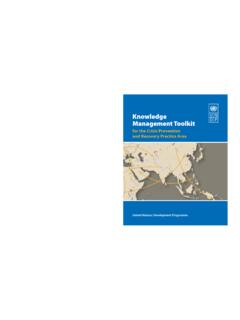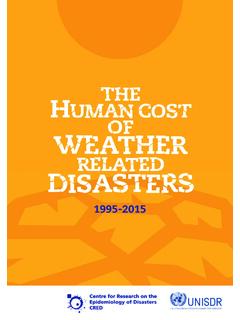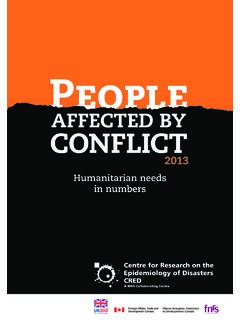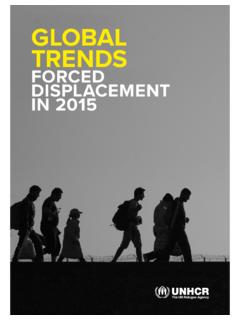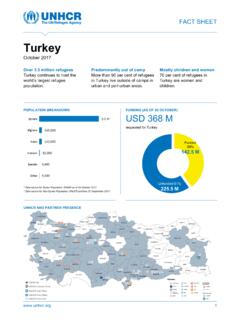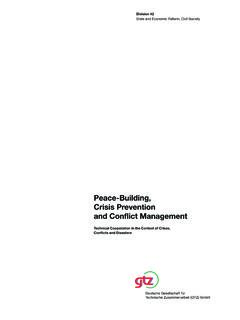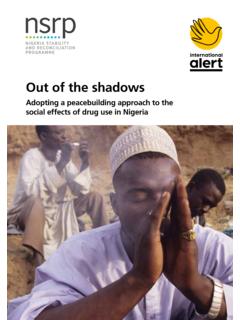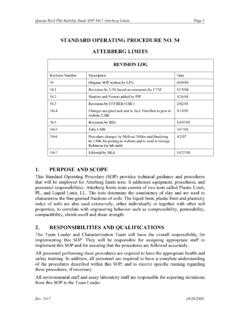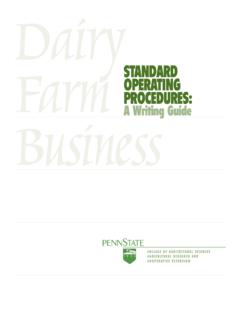Transcription of COVID19 Standard Operating Procedures (SOP)
1 COVID19 - Standard Operating Procedures UNHAS ROSS UNITED NATIONS HUMANITARIAN AIR SERVICE REPUBLIC OF SOUTH SUDAN COVID19 Standard Operating Procedures (SOP) COVID19 - Standard Operating Procedures UNHAS ROSS COVID19 SOP 2 Apr 2020 Page 1 of 20 Table of Contents SECTION 1 GENERAL .. 3 Scope .. 3 Background .. 3 Coronavirus Symptoms .. 3 Transmission .. 3 Staff and Operator Instructions .. 3 General guidance and 4 Personal Protective Equipment .. 5 SECTION 2 OPERATIONS .. 5 Pre-flight .. 5 Check-in and 5 Screening Process at entry .. 6 Screening Process at check-in area .. 6 Screening at the field Stations .. 7 Cost Recovery .. 7 Separation (isolation) .. 7 Screening items and their use .. 8 Loaders and helpers .. 9 In Flight .. 9 After 10 Management of Crew Exposure after Completed flight .. 11 Transportation of specimen .. 11 Medical Evacuation of Non-Critical COVID-19 suspected/symptomatic passengers.
2 12 SECTION 3 CONTRACTED AIR OPERATORS .. 16 Standard Operating Procedures .. 16 Business Continuity .. 16 Crew .. 17 Aircraft cleaning and Disinfection .. 17 Communication .. 18 COVID19 - Standard Operating Procedures UNHAS ROSS COVID19 SOP 2 Apr 2020 Page 2 of 20 RECORD OF REVISION Please note that this SOP and its revisions are distributed only by electronic means. Every time a revision is distributed, the entire SOP s digital file will be replaced by the new digital file version. This SOP will be placed on the Tresorit database and advised to all UNHAS staff, staff of contracted air operators and applicable WFP Staff and other key stakeholders as may be needed. Revision number Date Edited by Date distributed Version 1 25 Mar 2020 COVID FP 20 Mar 2020 COVID19 - Standard Operating Procedures UNHAS ROSS COVID19 SOP 2 Apr 2020 Page 3 of 20 SECTION 1 GENERAL Scope This SOP defines WFP Aviation/UNHAS Procedures to be followed when Operating in areas affected by the current outbreak of the coronavirus disease (COVID-19).
3 This SOP will be communicated to UNHAS staff, Operators, and user organisations. Background According to World Health Organization ( ), Coronaviruses (COVID-19) are a large family of viruses that cause illness ranging from the common cold to more severe diseases such as Middle East Respiratory Syndrome and Severe Acute Respiratory Syndrome. Common signs of infection include respiratory symptoms, fever, cough, shortness of breath, and breathing difficulties. In more severe cases, infection can cause pneumonia, severe acute respiratory syndrome, kidney failure and even death. Due to the lack of symptoms during the incubation period and the rapid spread of the virus, it can be assumed that cases of COVID-19 will generally increase within affected countries. Coronavirus Symptoms A person that presents the following symptoms may have the Covid-19 virus: Fever (38 C or higher) and/or one of the following symptoms: Persistent dry cough; Dizziness/vertigo; Difficulty breathing; Muscle pain, diarrhoea and vomiting; Appears obviously unwell.
4 Transmission People are thought to be most contagious when they are most symptomatic. Some spread might be possible before people show symptoms; there have been reports of this occurring with this new coronavirus, but this is not thought to be the main way the virus spreads. The World Health Organization states that the spread of COVID-19 between humans is being driven by droplet transmission. The virus is transmitted from a sick person to a healthy person through respiratory droplets when the sick person coughs or talks close to another person. COVID-19 can be spread by touching contaminated surfaces or objects, and then touching eyes, nose or mouth. COVID 19 may spread from contact with contaminated surfaces or objects. It is not certain how long the virus that causes COVID-19 survives on surfaces, but it seems to behave like other coronaviruses. Studies suggest that coronaviruses (including preliminary information on the COVID-19 virus) may remain on surfaces for a few hours or up to several days.
5 Staff and Operator Instructions All personnel are responsible to review and follow the guidance in this document as applicable. COVID19 - Standard Operating Procedures UNHAS ROSS COVID19 SOP 2 Apr 2020 Page 4 of 20 General guidance and directives For all UNHAS staff and Air Operators while in ROSS and in countries with confirmed cases: Avoid Public Transportation - Travel only in private transport when traveling between the airport/office and home/accommodations. Minimize contact with passengers, ground personnel, other staff, and reduce time in public areas while moving between the aircraft/office and the private transport. Minimize going out into the general population, avoid hand shaking (no touching ) and use social distancing (maintain a distance of approximately 1 meter if possible) whenever out in public and among passengers. Avoid crowds, shopping malls, sporting or mass events, and other situations likely to attract large numbers of people.
6 Wash your hands often with soap and water for at least 20 seconds or use at least a 60% alcohol-based hand sanitizer. Avoid touching your face (eyes, nose and mouth) because contaminated hands may transfer the virus to your body through these openings. Do not touch surfaces or objects that you suspect may be contaminated. When sneezing or coughing, cover your mouth and nose with bent elbow or tissue and immediately dispose of the tissue in an appropriate place. Self-monitor your health condition; operators should also follow the guidance provided by your employer s occupational health program. If suspected to be infected or exposed, take your temperature with a thermometer twice a day and watch for cough or difficulty breathing. Fever means feeling feverish or having a measured temperature of 38 degrees Celsius or higher. Immediately report any fever, cough, or difficulty breathing to any of the following: o UNHAS contacts: John Cassidy +211 926 225 434 Nikolay Riekhtin +211 922 845796 Kennedy Ooro +211 922 845 785 Mario Sibrian +211 922 465 5460 o WFP Country Office contacts Fiona LITHGOW +211 922 465 747 Brian LANGDON +211 922 654 670 o UN Medical Contacts UN Physician UNDP on-call number +211 920 694 196 UNMISS +211 912 173 563 o Employer Focal Person Face masks can limit transmission of the virus to others if you are sick or showing the symptoms as described above.
7 COVID19 - Standard Operating Procedures UNHAS ROSS COVID19 SOP 2 Apr 2020 Page 5 of 20 Notify your Focal Points above and the Medical Section if you had travelled to infected countries or you were exposed to individuals with suspected COVID-19. Contact UNHAS management or the Country Office Covid team if any support or further guidance is required. Stay informed by carefully reading circular and advisory mail sent by the WFP COVID team and also read information distributed through the WHO official website at the link for further information and guidelines. Personal Protective Equipment Air operators shall ensure availability of a Universal Precaution Kit as per ICAO Annex 6, Attachment A. This should include as a minimum: Germicidal disinfectant for surface cleaning Skin wipes Face/eye mask (separate or combined) Gloves (disposable) Protective apron Large absorbent towel Pick-up scoop with scraper Bio-hazard disposal waste bag Instructions UNHAS ROSS staff shall have Personal Protective Equipment (PPE) that may be a combination of the items above but as a minimum face masks (surgical or N95), gloves, disinfectant gels or access to washing station.
8 For all items refer to Annex 1 for specifications. All staff shall be trained on basic rules on how to put on/take off PPE (as described in Annex 2) by completing the following training: EVD training on the WHO website ( ) WHO training for COVID-19 SECTION 2 OPERATIONS Pre-flight UNHAS ROSS will monitor the spread of COVID-19 in country and undertake a risk assessment before each flight. If an operation to a COVID-19 affected area is required, additional precautionary measures such as reduced passenger seating configuration that ensures a minimum safety distance of one meter between passengers will apply. Check-in and Boarding UNHAS and/or the Air Operator staff shall provide information to passengers on the potential risk of COVID19 and advise on preventive hygiene measures. COVID19 - Standard Operating Procedures UNHAS ROSS COVID19 SOP 2 Apr 2020 Page 6 of 20 Screening Procedures shall be put in place at all locations for all staff and passengers for the purpose of flying on WFP aircraft.
9 This may include before entering air terminals. All staff and passengers shall be screened before entering any UNHAS compound and WFP aircraft. All UNHAS staff and porters should wear PPE comprising of a mask and gloves, and frequently use hand disinfectants, especially at air terminals that are congested. Screening Process at entry Operational steps to be performed: Where possible keep a distance from any person ideally 1 meter minimum. Check eligibility for entry, passenger and staff. Inform the passenger of screening reason and process. Observe passenger for any visible COVID-19 symptoms as per below. o Ask the passenger whether they feel sick and have any of the symptoms, including fever, coughing, sore throat, difficulty breathing, or feeling unwell in the past 24 hours. Check the temperature keeping distance and measuring temperature 5 cm in front of the temple. If the temperature reading is high (380C or higher) and the passenger has no other COVID-19 symptoms, ask the passenger to move to a shaded area and wait.
10 Retake their temperature again after 3-5 mins for an accurate reading. Clear the passenger if there are no symptoms and temperature below 380C. If temperature is still 380C or above a final reading can be made 5-10 mins later trying to calm and cool the person. If the temperature is still above 380C, separate the passenger as per below, point If the COVID19 symptoms are displayed by the passenger: o Provide them a mask to put on. o Inform them to move to the isolation area. o Inform your supervisor and contact the appropriate WFP Covid Focal point or UN Medical Section. If symptoms are present, follow separation actions per below, point and also inform the UNHAS Chief Air Transport Officer (CATO) or Deputy Chief Air Transport Officer (DCATO). Direct passenger to disinfect hands before entering. Screening Process at check-in area Operational steps to be performed: Clean- Disinfect the Check-in areas before using them.

